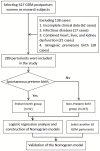Construction and validation of a novel nomogram for predicting spontaneous preterm birth in patients with gestational diabetes mellitus
- PMID: 39544809
- PMCID: PMC11558387
- DOI: 10.62347/MQQF2601
Construction and validation of a novel nomogram for predicting spontaneous preterm birth in patients with gestational diabetes mellitus
Abstract
Objective: To explore the influencing factors of spontaneous preterm birth (sPTB) in patients with gestational diabetes mellitus (GDM) and construct a nomogram model.
Methods: A retrospective analysis was conducted on the clinical data of 289 GDM patients who gave birth at Yangzhou University Affiliated Hospital from January 2021 to December 2022. The patients were divided into the sPTB (n = 52) and non-sPTB (n = 237) groups based on whether sPTB occurred. Logistic multivariate analysis was used to explore the influencing factors of sPTB in GDM patients and construct a nomogram model. The predictive performance of the nomogram model was evaluated using ROC curves and calibration curves in internal validation. Additionally, 62 GDM patients who visited Yangzhou University Affiliated Hospital from January 2023 to June 2023 were retrospectively selected for external validation of the prediction model.
Results: Logistic analysis showed that maternal age ≥30 years, pre-pregnancy BMI ≥26.3 kg/m2, history of spontaneous abortion, premature rupture of membranes, and oral glucose tolerance test (OGTT) fasting blood glucose ≥5.1 mmol/L were independent risk factors for sPTB in GDM patients (all P<0.05). In internal validation, the AUC value of the model's ROC curve was 0.901, and in external validation, the AUC value was 0.939. The calibration curve showed that the predicted probability was consistent with the actual probability. In addition, the sensitivity, specificity, and accuracy of the model in external validation were 84.21%, 81.40%, and 82.26%, respectively.
Conclusion: Maternal age ≥30 years, pre-pregnancy BMI ≥26.3 kg/m2, history of spontaneous abortion, premature rupture of membranes, and OGTT fasting blood glucose ≥5.1 mmol/L are independent risk factors for sPTB in GDM patients. The nomogram model based on these risk factors has high discrimination and accuracy in predicting sPTB in GDM patients.
Keywords: Gestational diabetes mellitus; logistic regression analysis; nomogram model; spontaneous preterm birth.
AJTR Copyright © 2024.
Conflict of interest statement
None.
Figures





Similar articles
-
Development and validation of a nomogram to predict spontaneous preterm birth in singleton gestation with short cervix and no history of spontaneous preterm birth.Heliyon. 2023 Sep 27;9(10):e20453. doi: 10.1016/j.heliyon.2023.e20453. eCollection 2023 Oct. Heliyon. 2023. PMID: 37790977 Free PMC article.
-
Development and validation of nomogram for the prediction of preterm delivery based on patient characteristics and circulating inflammatory cells in patients with gestational diabetes mellitus.Ann Transl Med. 2023 Jan 31;11(2):70. doi: 10.21037/atm-22-6223. Ann Transl Med. 2023. PMID: 36819579 Free PMC article.
-
Development and validation of a risk prediction model for preterm birth in women with gestational diabetes mellitus.Clin Endocrinol (Oxf). 2024 Sep;101(3):206-215. doi: 10.1111/cen.15044. Epub 2024 Mar 11. Clin Endocrinol (Oxf). 2024. PMID: 38462989
-
Establishment and validation of a predictive model for spontaneous preterm birth in singleton pregnant women.BMC Pregnancy Childbirth. 2024 Sep 11;24(1):595. doi: 10.1186/s12884-024-06772-w. BMC Pregnancy Childbirth. 2024. PMID: 39261755 Free PMC article.
-
The Immunomodulatory Role of Regulatory T Cells in Preterm Birth and Associated Pregnancy Outcomes.Int J Mol Sci. 2024 Nov 5;25(22):11878. doi: 10.3390/ijms252211878. Int J Mol Sci. 2024. PMID: 39595948 Free PMC article. Review.
References
-
- Dauengauer-Kirliene S, Domarkiene I, Pilypiene I, Zukauskaite G, Kucinskas V, Matuleviciene A. Causes of preterm birth: genetic factors in preterm birth and preterm infant phenotypes. J Obstet Gynaecol Res. 2023;49:781–793. - PubMed
LinkOut - more resources
Full Text Sources
